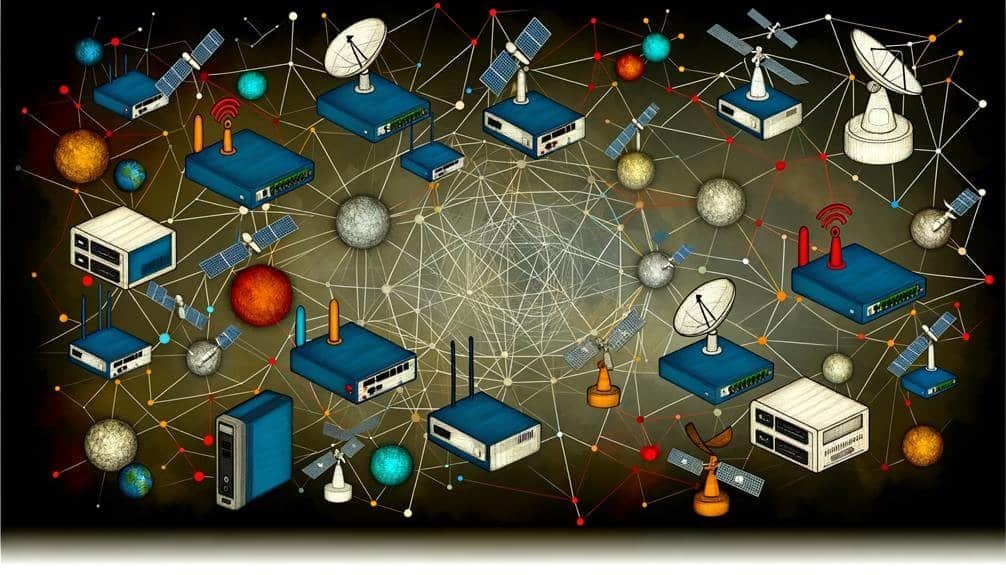What Are the Communication Protocols?
Communication protocols, those intricate systems that facilitate the exchange of information, are quite the fascinating subject. They play a crucial role in our modern world, ensuring that data flows smoothly and securely between devices and networks.
But have you ever wondered what exactly these protocols are and how they work? Well, buckle up, because we’re about to unravel the mysteries behind communication protocols and explore their various types, functions, and real-life examples.
So, get ready to dive into the captivating world of communication protocols and discover the secrets behind seamless communication.
Key Takeaways
- Communication protocols are sets of rules and guidelines that govern the exchange of information between devices or systems.
- They play a crucial role in ensuring seamless and efficient communication by establishing standards for format, timing, sequencing, and error handling of data transmission.
- Communication protocols enable devices to communicate effectively by providing a common language and structure for data transmission.
- They also establish rules for initiating and terminating communication, as well as methods for error detection and correction.
Definition of Communication Protocols
Communication protocols are sets of rules and guidelines that govern the exchange of information between devices or systems. They play a crucial role in ensuring seamless and efficient communication. Communication protocol standards are established to define the format, timing, sequencing, and error handling of data transmission. These standards ensure compatibility and interoperability between different devices and systems.
The role of communication protocols is to enable devices to communicate effectively by providing a common language and structure for data transmission. They establish the rules for initiating and terminating communication, as well as the methods for error detection and correction. By following these protocols, devices can exchange data reliably, efficiently, and securely.
Without communication protocols, it would be challenging for devices to understand and interpret the information being transmitted, leading to communication failures and data loss.
Types of Communication Protocols
Now let’s explore the different types of communication protocols that exist in networking. Communication protocols play a crucial role in ensuring the smooth transfer of data between devices on a network. They define the rules and procedures for transmitting and receiving data, ensuring that information is accurately and efficiently exchanged. Here are some common types of communication protocols:
| Protocol Name | Purpose | Examples |
|---|---|---|
| HTTP | Used for transferring web pages and other resources | HTTP, HTTPS |
| FTP | Allows for the transfer of files between systems | FTP, SFTP, TFTP |
| TCP/IP | Provides reliable and connection-oriented communication | TCP, IP |
| SMTP | Handles the transfer of emails | SMTP, POP3, IMAP |
These protocols are essential for establishing effective communication between devices, enabling the seamless flow of information across networks.
How Communication Protocols Work
To understand how communication protocols work, it’s important to grasp the underlying principles and mechanisms that govern their operation. Communication protocols play a crucial role in networking by facilitating the transfer of data between devices.
Here are five key aspects of how communication protocols work:
- Standardization: Communication protocols follow predefined standards to ensure compatibility and interoperability between different devices and systems.
- Addressing: Protocols use unique addresses to identify the source and destination of the data being transmitted.
- Encapsulation: Data is divided into smaller units and encapsulated with additional information, such as headers and trailers, to ensure reliable delivery.
- Error detection and correction: Protocols employ various techniques, such as checksums or error correction codes, to detect and correct errors that may occur during transmission.
- Flow control: Protocols implement mechanisms to regulate the flow of data, ensuring that receivers can handle and process it efficiently.
Importance of Communication Protocols
The importance of communication protocols lies in their ability to ensure seamless and efficient data transfer between devices and systems. Effective communication protocols are crucial for the smooth operation of various technologies and networks. They establish a common language and set of rules that devices can use to communicate with each other. Without such protocols, devices would struggle to understand and interpret the data they receive, leading to communication breakdowns and inefficiencies.
The impact of poor communication protocols can be detrimental. It can result in data corruption, loss, or delays, leading to errors, system failures, and compromised security. Inefficient communication protocols can also slow down processes, hinder productivity, and increase costs. Therefore, it’s essential to have robust and effective communication protocols in place to ensure the seamless flow of information and the smooth operation of devices and systems.
Examples of Communication Protocols
Effective communication protocols play a vital role in enabling seamless and efficient data transfer between devices and systems. To achieve this, there are commonly used protocols that adhere to specific protocol standards. Here are five examples of such protocols:
- Transmission Control Protocol (TCP): A reliable and connection-oriented protocol that guarantees the delivery of data packets in the correct order.
- Internet Protocol (IP): A protocol responsible for addressing and routing data packets across networks.
- Hypertext Transfer Protocol (HTTP): A protocol used for transmitting web pages and other resources over the internet.
- Simple Mail Transfer Protocol (SMTP): A protocol used for sending and receiving email messages. SMTP, a cornerstone protocol for email communication, operates effectively through a series of commands exchanged between servers. For those interested in grasping the intricacies of its functionality, exploring the understanding SMTP commands can provide deeper insight into how emails are dispatched and received smoothly across networks.
- File Transfer Protocol (FTP): A protocol for transferring files between a client and a server.
These commonly used protocols adhere to protocol standards, ensuring compatibility and interoperability between different systems and devices.
Conclusion
As you travel down the road of communication, you encounter a web of protocols, guiding you like signposts in a vast network.
These protocols, like vibrant threads, weave together different devices and systems, allowing them to exchange information seamlessly.
With each click, beep, or signal, they create a symphony of connection, bridging the gaps between individuals and machines.
Just as the roads guide travelers to their destinations, communication protocols pave the way for efficient and effective communication in our interconnected world.







